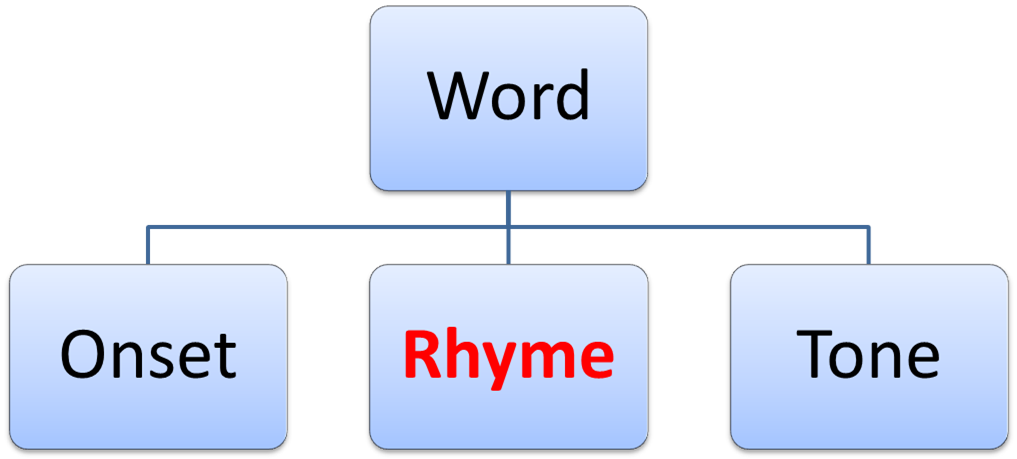Link to YouTube presentation: Chapter 1.3. Introduction
In Vietnamese, every syllable is written separately as a "word". This does not mean all meaningful words are monosyllabled, though many are. For example:
- sư tử (lion) contains 2 syllables
- thú y sĩ (veterinarian) contains three syllables
In old books, such words are hyphenated (sư-tử, thú-y-sĩ), but today the hyphen is generally omited. Hyphenation is still used in phonetic transcription of foreign words, such as pic-nic (picnic), Nô-en (Noël), lô-gic (logic), ghi-ta (guitar), sô-cô-la (chocolate), though the trend of writing these words in their native foreign forms is gaining popularity among the younger generations.
In this course, for convenience the term "word" is used loosely to refer to one written unit, which is one syllable. To read Vietnamese, we can read one syllable at a time, or one "word" at a time.
The Word Structure:
A Vietnamese word consists of three main components: An onset , a rhyme, and a tone
 1. Onset: the starting consonant, can be missing.
1. Onset: the starting consonant, can be missing.
2. Rhyme: always starts with a vowel, essential and can't be missing.
3. Tone: One tone per syllable (word). Tone mark can be missing, but tone is essential.
- The absence of tone mark implies the neutral tone.
- Tone mark is placed above or beneath the vowel of the rhyme.
Compared to a mono-syllabled word in English, Vietnamese words are similar accept:
1. Each syllable carries a tone, denoted by a tone mark or the absence of a tone mark (neutral tone).
2. The ending consonant (coda), which is part of the rhyme, is not pronounced.
Vietnamese is phonetic:
Unlike English, Vietnamese onsets, rhymes, and tones are pronounced consistently when placed in different words. In English, for example, the onset "c" sounds differently in cat and cent, "ch" sounds differently in chin and chaos. Similarly, the rhyme "o" sounds differently in to and go, and the rhyme “one” sounds differently in one, gone, done, and tone! It is not so in Vietnamese. In Vietnamese, once you remember the sound of each component (onset, rhyme, or tone), you can mix and match and apply the same sound consistently across different words with very few exceptions. Thus, it is easy to "sound out" words to read Vietnamese.
Method of Reading:
To "sound out" words, we need to use the letter phonetic sounds, not their names. Sounding out a word is then simply to combine the sounds of its three components: the onset, the rhyme, and the tone. Therefore, in this course we will learn these three components separately, then form words by mixing and matching them.
For beginner readers, instead of phonetically sounding out one letter at a time from left to right, we recommend recognizing the rhyme first before combining the three components.
How do we "recognize" the sound of a rhyme? Two popular methods are:
-
Sound it out
-
Remember them by sight (similar to "sight words" in English).
-
Note that we recommend "sight reading" the whole rhyme, not further analyzing them into sub-components such as nucleus and coda. The only thing we need to remember about coda, the ending consonant, is that it is silent in Vietnamese.
-
Sounding out rhymes by combining individual phonemes in a rhyme is helpful when you must guess the sound of a completely new rhyme. If you don't have to guess (by having a tutor or audio clips for reference), learning rhymes by sight is a faster. There are only about 160 rhymes in Vietnamese, which might sound like a lot to remember "by sight". But imagine, after only a handful of consonants, 6 tones, and about 160 rhymes, you can read a whole new language!
The method of "recognizing the rhyme first" works best for beginners. Reading whole words by sight would come naturally with practice.
Method of Reading (for beginner readers):
- Step 1: Recognize the rhyme
- Step 2: Combine the consonant onset (if there is one) with the rhyme
- Step 3: Add the tone.
Why do we recommend recognizing the rhyme first? Is it necessary?
No, it's not necessary for sight (visual) learners. If you can naturally remember whole words by sight, do learn new words by sight!
For most others, memorizing 160 rhymes or so is still more efficient than memorizing thousands of new words.
Recognizing the rhyme first does require efforts. It is not a natural process because the rhyme resides to the right of a word while we read from left to right. Thus, it is an intuitive tendency to sound out a word one letter at a time from left to right without recognizing the rhyme first. This approach is painful, inefficient, and illogical at times. Thus, for beginners please do take efforts to recognize the rhyme first, then combine the onset with the rhyme as a whole instead of combining individual letters from left to right.
In summary, reading words is about combining the sounds of onset, rhyme, and tone:
-
Onset: easy to remember, most consonants are similar to English. There are only 17 consonants and 10 compound consonants (digraphs).
-
Rhymes: Rhymes can be simple or more complex. There are close to 160 rhymes in Vietnamese.
-
Tones: There are only 6 tones, 5 of which require tone marks.
After learning the consonant onsets and the tones, which are only a handful, the "bottle neck" of reading is the rhyme. Therefore, for beginners, recognizing the rhyme first would speed up the process of learning to read.
Previous: 1.2. The Vietnamese Tones Next: Part II - Words with Simple Rhymes
